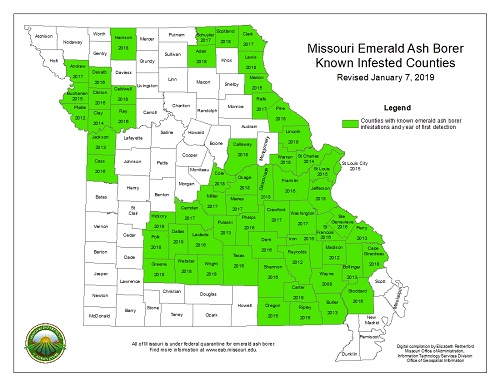AgEBB-MU CAFNR Extension
Green Horizons
Volume 23, Number 1
Winter 2019
Agroforestry
EAB Update: Where Are We Eleven Years Later?
By Sarah Phipps | Missouri Department of Agriculture
Emerald Ash Borer (EAB) was first discovered in Missouri in 2008 at the Greenville Recreation Area in Wayne County. The small, metallic green beetle native to Asia has decimated billions of ash trees in North America as the larvae feed just under the bark diminishing the water and nutrient conducting tissues. Since the initial quarantine was put in place, the beetle spread to three more counties in 2012, five more in 2013 and two more in 2014. Its march across Missouri has continued ever since. The beetle remains a step ahead by attacking the ash trees from the top down, allowing the beetles to avoid detection in new areas for up to five years before the damage is often noticed. A subsequent tree-ring analysis at the initial Wayne County campsite revealed that the infestation was present for at least five to six years prior to detection. Working on 11 years post 'first detection' in our state, EAB is now found in over half of Missouri's counties - a total of 60 counties and the City of St. Louis! A total of 20 new counties alone were confirmed to have EAB in 2018: Adair, Caldwell, Callaway, Cape Girardeau, Cole, Dallas, Gasconade, Greene, Harrison, Hickory, Jefferson, Lewis, Lincoln, Osage, Pike, Polk, Scotland, Warren, Webster and Wright.
 |
https://agriculture.mo.gov/plants/pests/eab-management-guide.pdf |
Various management plans have been in place throughout the years across our region, including: city tree surveys, replacing dead and declining ash trees, treating select trees, and also releasing parasitoid wasps that attack the EAB eggs and larvae. EAB traps are being used in counties where infestation has not yet been determined to monitor and provide new detection information so municipalities, landowners and homeowners can make management decisions based on the proximity of EAB. Insecticide treatment should only be considered when EAB has been found within your county or within 15 miles of counties that adjoin infested counties.
EAB serves as a poster child for how an invasive pest can become established in an area. EAB is a devastating pest, especially in city landscapes where ash composes on average 14 percent of the trees and up to 30 percent in other communities. This emphasizes how critical prevention and early detection efforts are for other invasive pests. If an oak-feeding pest, such as the gypsy moth were to establish in Missouri, the results would be horrendous for our forests and our economy. While it's too late to prevent EAB from getting into our state, we need everyone's help to avoid further infestations from other invasive wood-boring insects by spreading the word to always purchase local firewood and never move untreated wood farther than 50 miles from where it was harvested to prevent long distance movement of pests.
Missourians can help by learning to identify signs of EAB and report possible infestations in counties where the pest has not yet been confirmed. For a map of EAB's spread across Missouri and detailed information on identification, visit eab.missouri.edu. Report suspected EAB damage in new counties by contacting MDC's Forest Pest Office at 866-716-9974 (email: forest.health@mdc.mo.gov) or contacting Missouri Department of Agriculture's State Entomologist at 573-751-5505 (email: collin.wamsley@mda.mo.gov).
More information about Invasive Forests Pests can be found at: www.dontmovefirewood.org and www.treepests.missouri.edu
